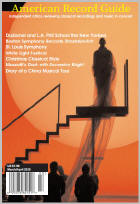Texte paru dans: / Appeared in:
Harmonia Mundi |
|
|
Outil de traduction ~ (Très approximatif) |
|
|
Reviewer: Catherine
Moore If you saw “Gesualdo Madrigals” in a list of recordings released in the past couple of years to celebrate the 40th anniversary (in 2019) of Les Arts Florissants you might assume that it is a reissue, honoring the ensemble’s past success. But it’s not. Recorded in July 2019, it’s the start of a brand new project to record all of Gesualdo’s madrigals. Director (and tenor) Paul Agnew—who since 2013 has shared the artistic directorship of Les Arts Florissants with ensemble founder William Christie—writes about what madrigals meant to composers in the past and mean to him today: “I was first attracted to the madrigal repertoire, and particularly to the works of Claudio Monteverdi, because it is clear that composers of the time used the madrigal as a laboratory for dramatic experimentation.”
Gesualdo’s first two books of
madrigals were published in 1594, the year after he married Leonora d’Este,
cousin of the Duke of Ferrara, Alfonso II d’Este. The composer found himself
in what was regarded as one of the finest musical courts in Europe,
surrounded by invention and creativity. Gesualdo’s own most strikingly
chromatic madrigals did not come until the later madrigal books. Here we
find a composer who “shows his perfect mastery of the compositional
principles specific to the madrigal form [and who] scrupulously respects the
established norms”.
The performances are very
fine. Gentle cascades across the voices characterize ‘Hai Rotto, E Sciolto,
E Spento A Poco A Poco’ and a soft tapering on the words “Let death not
postpone” aptly capture the ecstacy of sexual love in ‘Se Cosi Dolce E Il
Duolo’. The ensemble’s variety of expression, color palette, flexibility of
speed, attack, and articulation all contribute to the beautiful and
satisfying interpretations.
The booklet essays emphasize that Les Arts Florissants has a long history of bringing older music back to life, the point of its work being “to refresh, to breathe new life into an object that would enable it to make sense to us today”. They have also been strong advocates for training (and making room for) younger generations of singers and musicians who carry on the work and look to the future.
Notes,
texts, translations. | |
|
|
|
|
Cliquez l'un ou l'autre
bouton pour découvrir bien d'autres critiques de CD |
|




